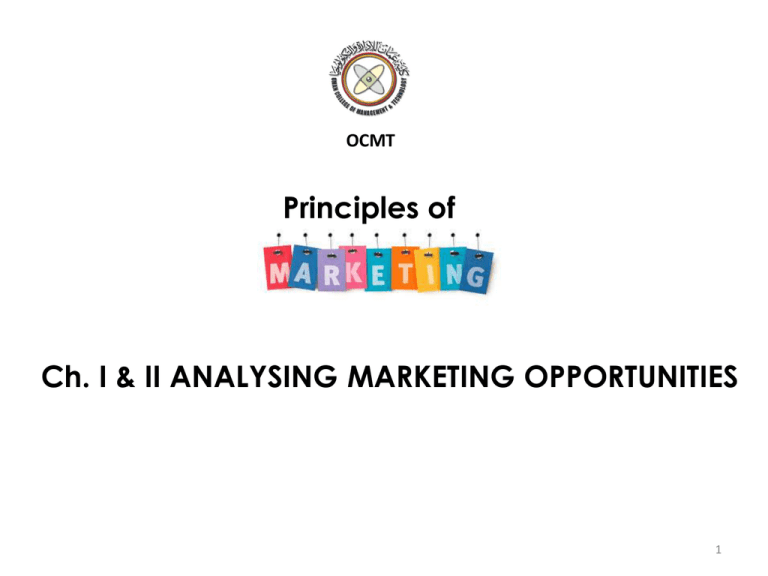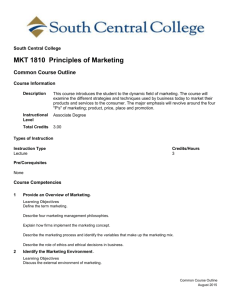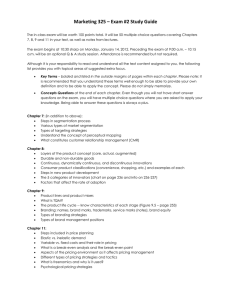Document - Oman College of Management & Technology
advertisement

OCMT Principles of Ch. I & II ANALYSING MARKETING OPPORTUNITIES 1 Contents 1. 2. 3. 4. Pricing strategies Marketing environment Target market and market segmentation Buyer behavior: meaning and factors influencing buyer behavior 5. Buying decision process: buying roles 6. Stages of buying decision process 2 WHAT IS PRICING? • Pricing is the process of determining what a company will receive in exchange for its product. 3 Pricing Strategies 4 Penetration Pricing • Penetration pricing is a pricing strategy in which the price is set low to ‘penetrate the market’ to secure high volume. It is typical in mass market products like chocolate bars, food stuffs, household goods, etc. • Penetration pricing strategy is suitable for products with long anticipated life cycles. It is useful for launching a product into a new market. 5 Market Skimming • Market skimming is a pricing strategy in which high price is set to skim the profit from the market. It may generate low volume of sales. • Skimming strategy is suitable for products that have short life cycles or which will face competition at some point in the future (e.g. after a patent runs out) • Examples include: Play-station, jewellery, digital technology, new DVDs, etc. 6 Value Pricing • Value pricing is a pricing strategy where price is set in accordance with customer perceptions about the value of the product. • Examples include status products/exclusive products like premium cars. 7 Loss Leader • Loss leader is a pricing strategy where goods or services are deliberately sold below cost to encourage sales elsewhere. • Loss leader pricing strategy is typical in supermarkets, e.g. at Christmas, selling bottles of gin at £3 in the hope that people will be attracted to the store and buy other things. • Purchases of other items more than covers ‘loss’ on item sold e.g. ‘Free’ mobile phone when taking on contract package 8 Psychological Pricing • Psychological pricing is a pricing strategy that is used to play on consumer perceptions. For example the goods are priced at £9.99 instead of £10! 9 Tender Pricing • Many contracts awarded on a tender basis • Firm (or firms) submit their price for carrying out the work • Purchaser then chooses which represents best value • Mostly done in secret 10 Price Discrimination • Charging a different price for the same good/service in different markets • Requires each market to be impenetrable • Requires different price elasticity of demand in each market 11 Destroyer Pricing/Predatory Pricing • Deliberate price cutting or offer of ‘free gifts/products’ to force rivals (normally smaller and weaker) out of business or prevent new entrants • Anti-competitive and illegal if it can be proved 12 Cost-Plus Pricing • Calculation of the average cost (AC) plus a mark up • AC = Total Cost/Output 13 MARKETING ENVIRONMENT • The forces that directly and indirectly influence an organization’s capability to undertake its business. Components of Marketing Environment • Internal environment : Forces and actions inside the firm that affect the marketing operation composed of internal stake holders and the other functional areas within the business organization. • External environment • Micro environment - The factors in the immediate environment • Macro environment - Broad forces which shape the character of opportunities and threats. 14 Marketing Environment Macro environment Micro environment Cultural Public Internal environment Competitors Men Money Machinery Materials Markets Company Suppliers Political Intermediaries Technological Demographic Customers Economic Natural 15 THE INTERNAL ENVIRONMENT All factors that are internal to the organization are known as the 'internal environment'. They are generally audited by applying the 'Five Ms' which are Men, Money, Machinery, Materials and Markets. The internal environment is as important for managing change as the external. As marketers we call the process of managing internal change 'internal marketing’. THE EXTERNALL ENVIRONMENT All factors that are external to the organization are known as the ‘external environment'. They are broad forces which shape the character of opportunities and threats. The external environment comprises 16 Micro environment • • • 1. 2. 3. 4. 5. The forces close to the company that affects its ability to serve. It comprises all those organizations and individuals who directly affect the activities of a company. All factors which impact directly on a firm and its activities in relation to a particular market. Suppliers The marketing channel Customers. Competitors Public Macro environment Macro environment refers to those factors which are external to company’s activities and do not concern the immediate environment. It comprises general forces that affect all business activities in market. They are cultural, political, technological, natural, economic and demographic. 17 MARKET SEGMENTATION Market segmentation is a marketing strategy that involves dividing a broad target market into subsets of consumers who have common needs, and then designing and implementing strategies to target their needs and desires using media channels and other touchpoints that best allow reaching them. TARGET MARKET A target market is a group of customers that the business has decided to aim its marketing efforts and ultimately its merchandise towards. 18 BUYER BEHAVIOR • Buyer behavior is the study of individuals, groups, or organizations and the processes they use to select, secure, and dispose of products, services, experiences, or ideas to satisfy needs and the impacts that these processes have on the consumer and society. 19 Factors influencing Consumer Behavior 20 Factors Affecting Consumer Behavior Membership groups have a direct influence and to which a person belongs. Aspirational groups are groups to which an individual wishes to belong. Reference groups are groups that form a comparison or reference in forming attitudes or behavior. Opinion leaders are people within a reference group with special skills, knowledge, personality, or other characteristics that can exert social influence on others. Family is the most important consumer-buying organization in society. Social roles and status are the groups, family, clubs, and organizations to which a person belongs that can define role and social status. Culture is a shared set of beliefs, values and patterns of behaviour common to a group of people. Subcultures are groups of people within a culture with shared value systems based on common life experiences and situations. For example: Chinese, Indians, Malays, Eurasians Social classes are society’s relatively permanent and ordered divisions whose members share similar values, interests, and behaviors. Social classes are measured by a combination of occupation, income, education, wealth, and other variables. The major social classes are upper upper class, upper middle class, middle class, upper lower class, lower lower class. 21 Factors Affecting Consumer Behavior Personality refers to the unique psychological characteristics that lead to consistent and lasting responses to the consumer’s environment. Brand personality refers to the specific mix of human traits that may be attributed to a particular brand. Self-concept refers to people’s possessions that contribute to and reflect their identities. Psychological Factors Motivation: A motive is a need that is sufficiently pressing to direct the person to seek satisfaction. Abraham Maslow’s Hierarchy of Needs • People are driven by particular needs at particular times. • Human needs are arranged in a hierarchy from most pressing to least pressing. • Perception is the process by which people select, organize, and interpret information to form a meaningful picture of the world. • Learning is the changes in an individual’s behavior arising from experience. 22 Factors Affecting Consumer Behavior Beliefs and Attitudes • Belief is a descriptive thought that a person has about something based on knowledge, opinion and faith. • Attitude describes a person’s relatively consistent evaluations, feelings, and tendencies toward an object or idea. 23 BUYING ROLES Five roles people might play in a buying decision 1 Initiator A person who first suggests the idea of buying the product 2 Influencer A person whose view or advice influences the decision 3 Decider A person who decides on any component of a buying decision: whether to buy, what to buy, how to buy, or where to buy 4 Buyer The person who makes the actual purchase 5 User A person who consumes or uses the product or service 24 Buying Decision Process Five stages in the buyer decision process 1. Need recognition 2. Information search 3. Evaluation of alternatives 4. Purchase decision 5. Post-purchase behavior 25 The Buyer Decision Process 3. Evaluation of Alternatives 1. Need Recognition • Need recognition occurs when the buyer recognizes a problem or need triggered by internal stimuli and external stimuli Evaluation of alternatives is how the consumer processes information to arrive at brand choices. 2. Information Search consumer to buy the most preferred brand. Information search is the amount of The purchase decision can be affected by information needed in the buying attitudes of others and unexpected process and depends on the strength of situational factors the drive, the amount of information you 5. Post-Purchase behavior The post-purchase behavior is the start with, the ease of obtaining the information, the value placed on the additional information, and the satisfaction from searching. 4. Purchase Decision The purchase decision is the act by the satisfaction or dissatisfaction the consumer feels about the purchase. It is the relationship between consumer’s expectations and product’s perceived performance 26






